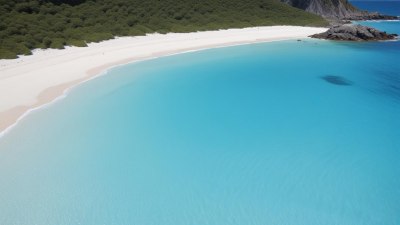Why a Remote Beach Has the Bluest Water You'll Ever See
Discover the secrets behind the stunning blue waters of a remote beach and what makes it a must-visit destination.

This image was created with the assistance of Freepik
Visiting a remote beach with the bluest water you’ll ever see is an experience akin to stepping into a postcard. These stunning locales entice travelers with their serene beauty and vibrant shades of blue, a sight that seems almost otherworldly. In this article, we explore the factors that contribute to the extraordinary color of the water, the allure of remote beaches, and the ecological significance of preserving these picturesque environments.
Understanding Water Color
The color of ocean water is primarily influenced by several natural factors: the angle of the sun, the presence and type of organisms, and the physical properties of the water itself. When sunlight hits the water, it scatters light waves, and different colors are absorbed differently. Water absorbs the longer wavelengths of light, such as reds and yellows, while scattering the shorter wavelengths, primarily blues and greens. This scattering phenomenon creates the blue hues that we often associate with clear waters.
Factors Contributing to the Bluest Water
To comprehend why certain beaches display the brightest blues, we must consider various environmental aspects. First is the purity of the water. Remote beaches typically have lower levels of pollution, which allows for clearer and more vibrant water. Algae and other particulates can cloud water, altering its color and reducing its brightness. Additionally, the sediment in the water plays a crucial role. A sandy sea floor with light-colored sands will reflect sunlight vividly, enhancing the water’s blue tint.
Another significant factor is the surrounding environment. Coastal areas that are isolated from industrial activities are better preserved, promoting a healthy ecosystem. Coral reefs, which are often found near these beautiful beaches, can also enhance the clarity and color of the water. The vibrant marine life in these areas adds another layer of magnificence to the scene, as the presence of healthy corals helps in a comprehensive filtration of the water.
Cultural and Geological Influences
The geology of the area surrounding a beach can also influence its water color. Beaches formed from limestone tend to have lighter, clearer water due to the calcium carbonate that reflects light efficiently. Additionally, the geological history of a region can affect the fauna and flora present, which in turn impacts water clarity and color—areas with beautiful coral reefs often have the clearest and bluest water around them. The culture of preservation surrounding these remote areas also contributes, as communities often strive to keep their environmental heritage intact, prohibiting pollution and embracing sustainable practices.
In many cultures that prioritize these remote beach environments, there is a strong connection to nature that prohibits overdevelopment or excessive tourism, allowing water clarity and the natural habitat to thrive. Such places are often seen as treasures, with local populations protecting them fiercely and ensuring that visitors can witness their natural beauty without the detriment of industrial or commercial exploitation.
The Serene Experience of Remote Beaches
Aside from their natural beauty, remote beaches provide a serene escape from the noise of modern life. Nestled away from crowded urban areas, these beaches often require a bit of effort to reach, but the reward is an untouched paradise that offers solitude and tranquility. Many travelers seek out these secluded locations for a variety of reasons. Engaging in activities like snorkeling or diving in crystal clear waters allows visitors to witness the underwater ecosystems firsthand, filled with colorful fish and intricate corals.
The sense of adventure derived from reaching these remote beaches adds to the overall allure. Whether it’s a hiking trail through verdant forests or a boat ride across open waters, the journey to these hidden gems can be just as exhilarating as the destination itself. Here, individuals can unwind, take in breathtaking views, and forget the hustle and bustle of everyday life.
Conservation Efforts
With the growing interest in visiting these idyllic locales, it’s essential to address the need for preservation and responsible tourism. Areas with the bluest waters face threats from pollution, overfishing, and climate change. Communities and organizations worldwide are stepping up to protect these precious environments. Sustainable tourism practices help ensure that visitors can enjoy these beautiful landscapes without causing harm. Regulations regarding waste disposal, strict fishing quotas, and conservation initiatives are critical in maintaining the health of these ecosystems.
Moreover, educating visitors on the importance of preserving these areas is invaluable. Nature tours, informational signage, and outreach programs help strengthen the bond between tourists and the environment, fostering a sense of responsibility.
Unforgettable Travel Destinations
Among the world’s most famous remote beaches with stunningly blue waters are places like the Maldives, which offers crystal-clear lagoons teeming with marine life and white sandy shores. Another is the island of Bora Bora in French Polynesia, where the vibrant blues of its lagoon are breathtaking. Locations in the Caribbean, such as the Exuma Cays in the Bahamas, are famous for their range of shades from turquoise to deep blue. Moreover, Kenyan beaches along the Indian Ocean boast beautiful coral reefs and warm waters, drawing nature lovers and snorkelers to their shores.
Each of these destinations has its own unique vibe and ecological significance, making them essential parts of our planet's environmental tapestry. Traveling to these beaches offers visitors not just wanderlust but also a chance to connect with nature in a meaningful way.
The allure of remote beaches with the bluest water is undeniable. They represent the unblemished beauty of nature, where the water's color reflects purity and the health of the surrounding environment. Understanding the factors that contribute to this vibrant blue not only enriches our appreciation of these locales but also underscores the importance of responsible travel and conservation efforts. As travelers continue to seek out these stunning destinations, we must remember to respect and protect our planet's natural wonders for future generations to enjoy.
Whether it’s the adventure of reaching a secluded beach or the experience of plunging into its crystal-clear waters, the joy these places bring is unparalleled. Embrace the spirit of wanderlust, and explore the breathtaking remote beaches that boast brilliant blue water. Appreciate their beauty, learn about their ecosystems, and join in an active role to keep them pristine. In doing so, we not only satisfy our own yearning for adventure but also contribute to the preservation of our planet's most magnificent environments.











